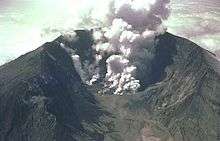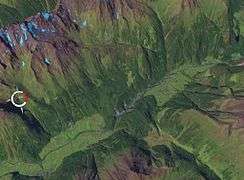Sturzstrom

A sturzstrom (German word composed of Sturz (fall) and Strom (stream)) is a unique type of landslide consisting of soil and rock which has a great horizontal movement when compared to its initial vertical drop — as much as 20 or 30 times the vertical distance. By contrast a normal landslide will typically travel a horizontal distance that is less than twice the distance that the material has fallen.[1] Sturzstroms have similarities to the flow in glaciers, mudflows, and lava flows. Sturzstroms flow across land fairly easily, and their mobility increases when volume increases. They have been found on other bodies in the Solar System, including the Moon, Mars, Venus, Io, Callisto, Iapetus,[2][1] and Phobos.
Movement
A sturzstrom is caused by a trigger, such as heavy rains, earthquakes, or volcanoes. It moves rapidly, but does not necessarily require water to be present within it to move. Therefore, there is no definite explanation for their movement. One theory, acoustic fluidization, hypothesizes that vibrations caused by the sound of the slide reduce the overall friction present in the slide and allow it to travel much greater distances.[5] Another theory involves air pockets forming under the slide and providing a cushion that the slide rides over to generate its long run-out distances, although the merit of this theory has been called into question by the presence of sturzstroms in vacuums such as on the Moon and Phobos.
Observation of slides on Iapetus suggest tiny contact points between bits of ice debris may heat them up considerably, causing melting and forming a more fluid — and thus less friction-limited — mass of material.[1]
_Kofels_Structure_Austria.jpg)
The amount of energy in a sturzstrom is much higher than in a typical landslide. Once moving, it can ride over nearly any terrain and will cover more horizontal ground than downward-sloped ground. Its momentum can even carry it up small hills.[6] In the large Köfels landslide, which flowed into the Ötztal valley in Tyrol, Austria, deposits of fused rocks, called "frictionite" or "hyalomylonite", were found in the landslide debris. This has been hypothesized to be volcanic in origin or the result of a meteorite impact, but the leading hypothesis is that it was due to the large amount of internal friction. Friction between static and moving rocks can create enough heat to fuse rocks to form frictionite (hyalomylonite).[7][8]
See also
| Wikimedia Commons has media related to Sturzstrom. |
References
- 1 2 3 Palmer, Jason (29 July 2012). "Saturn moon Iapetus' huge landslides stir intrigue". BBC News. Retrieved 2012-07-29.
- ↑ Singer, Kelsi N.; McKinnon, William B.; Schenk, Paul M.; Moore, Jeffrey M. (29 July 2012). "Massive ice avalanches on Iapetus mobilized by friction reduction during flash heating". Nature.
- ↑ Ivy-Ochs S, Heuberger H, Kubik PW, Kerschner H, Bonani G, Frank M, and Schlüchter C. (1998). The age of the Köfels event — relative, 14C, and cosmogenic isotope dating of an early Holocene landslide in the central Alps (Tyrol, Austria). Zeitschrift für Gletscherkunde und Glazialgeologie, (34):57–70.
- ↑ Kurt Nicolussi, Christoph Spötlb, Andrea Thurnera, Paula J. Reimer (2015). Precise radiocarbon dating of the giant Köfels landslide (Eastern Alps, Austria), Geomorphology, Volume 243, August 2015, Pages 87–91
- ↑ Collins, G.S.; Melosh. "Acoustic Fluidization and the Extraordinary Mobility of Sturzstroms" (PDF).
- ↑ Hsü, Kenneth J. (1975). "Catastrophic Debris Streams (Sturzstroms) Generated by Rockfalls". Geological Society of America Bulletin. 86 (1): 129–140. Bibcode:1975GSAB...86..129H. doi:10.1130/0016-7606(1975)86<129:CDSSGB>2.0.CO;2. Retrieved 2010.
Sturzstroms can move along a flat course for unexpectedly large distances and may surge upward by the power of their momentum.
Check date values in:|access-date=(help) - ↑ Erismann, T.H. (1979). "Mechanisms of Large Landslides". Rock Mechanics. 12 (1): 15–46. Bibcode:1979RMFMR..12...15E. doi:10.1007/BF01241087.
- ↑ Weidinger JT, Korup O (2008). "Frictionite as evidence for a large Late Quaternary rockslide near Kanchenjunga, Sikkim Himalayas, India — Implications for extreme events in mountain relief destruction". Geomorphology. 103 (1): 57–65. doi:10.1016/j.geomorph.2007.10.021.
